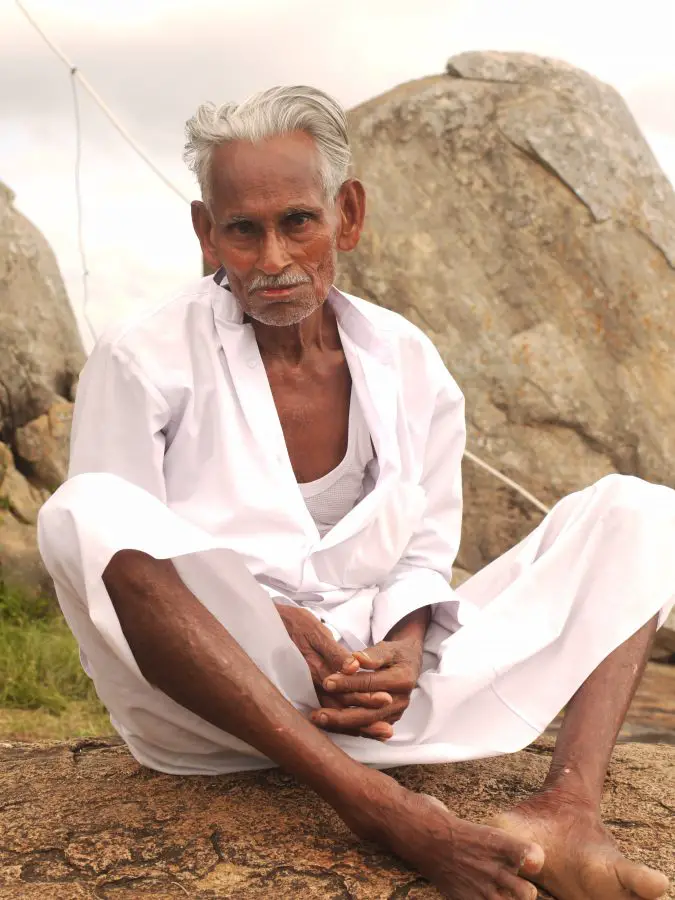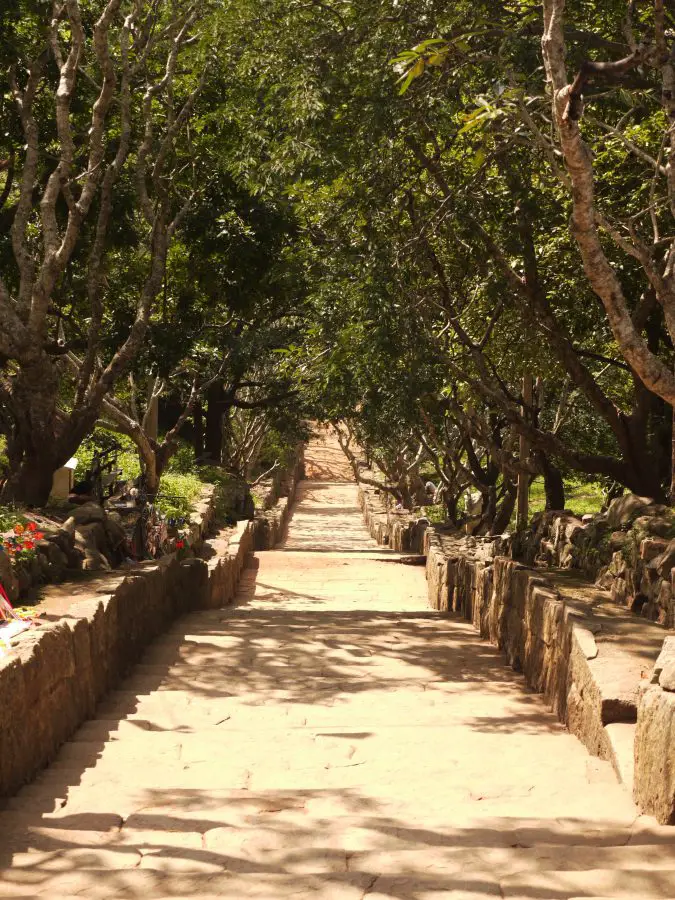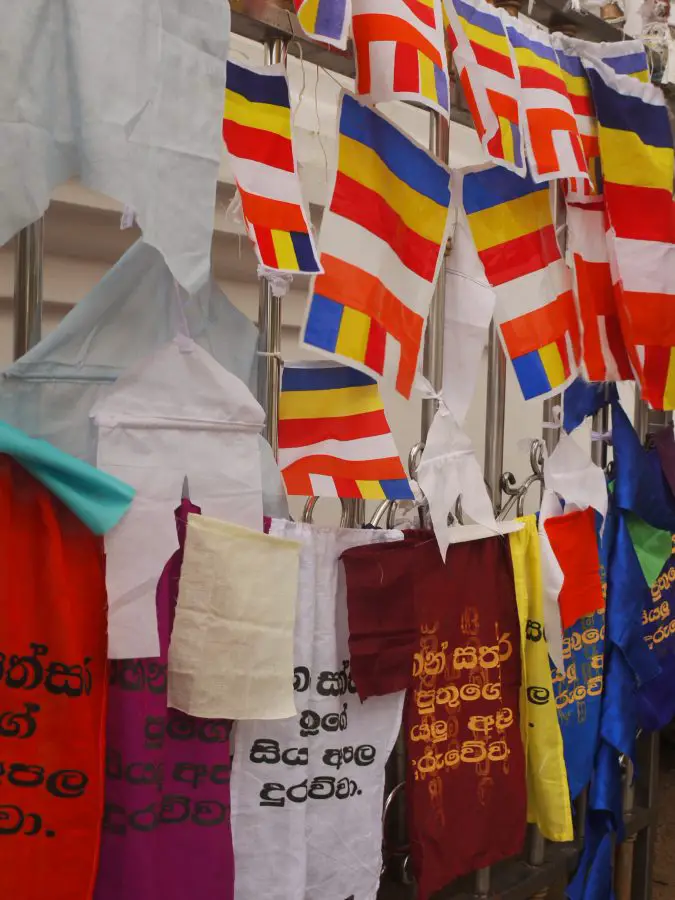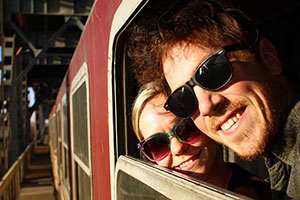A sacred city of ancient temples, ruined dagobas, enormous monuments and the oldest tree in the world was to be our first stop in ‘Sri Lanka’s cultural triangle’, as it has become known. Forming the three main points of the triangle are Anuradhapura, Pollanaruwa and Sigiriya and charging between twenty and thirty dollars per site, we really feel the Sri Lankan Tourist Board has lost the run of itself a bit. To put it in perspective we had visited the Taj Mahal, one of the great wonders of the world, just a few months previous and were charged seven hundred and fifty rupees, which is approximately eight euro, seventy five cents ($12). Reaching the top of the Eiffel Tower cost only fourteen euro ($18), entering the Statue of Liberty was only $12 (nine euro, which included the ferry) and walking Rome’s Colosseum
was fifteen euro ($20). These famous landmarks, scattered around the world, are known by everyone, young and old, yet these cultural sights of Sri Lanka are hardly known outside of the country, where is the justification in charging these prices? It will discourage people from making time to see and appreciate them when they are this expensive.Virtually every backpacker we had met on our travels in Sri Lanka to this point had felt the same way about the extravagant entrance fees and had refused to pay them, we were no different. Dotted throughout the primary ‘triangle’ are a number of other smaller, quieter, cheaper and equally impressive ancient sites which are easily accessible and so after a little time amongst the main attractions of Anuradhapura we sought out other, more affordable but equally interesting, venues.
Renting two pretty old-school bikes, we pedalled the thirteen or so kilometres east to the tiny town of Mihintale, another of Sri Lanka’s ancient cities. Along the roadway are a number of ancient ruined dagobas where a few locals had arrived to pray, light butter lamps and find solace from the sunshine in the shade of the surrounding trees. Monkeys disturbed the peace arriving in gangs, eating coconut offerings and generally making a nuisance of themselves. Locking our bikes up, under the watchful
eye of a couple of chipmunks, we began the ascent to the top of Mihintale Hill where the main temple complex awaited us. Climbing the steps was pretty straight forward and not as challenging as we initially thought, passing a number of ancient ruins on the way including the Mihintale Tablets, two large inscribed stones outlining the rules which Buddhist monks should live their lives by. Keeping us entertained as we walked was the wildlife. Along the steps we encountered a large monitor lizard, a squirrel ran across the path, numerous chipmunks came out to greet us and on reaching the top we met some funky looking pheasants pecking around in the dusty ground. Close by another monitor lizard was keeping the resident tortises on their toes. With only a few locals to share the top of the hill with we strolled around the whitewashed Ambasthale Dagoba, with the tiny orange Buddha figure on the western side, marking the spot where Mahinda, the great Indian Buddhist Emperor, met King Devanampiya in 247BC, testing the King and converting him to Buddhism. Sri Lankans believe that this is the moment when Buddhism was introduced to the island.
Surrounding the Ambasthale Dagoba are three higher points, one a view point reached by clambering up smooth rock and offering amazing views of the surrounding countryside, to Anuradhapura and beyond. A large Buddha statue and the enormous Mahaseya Dagoba occupy the other two points. Hungry from the cycle and uphill walk we happily flew down the steep road on our bikes to grab some rice and curry before beginning the journey back to Anuradhapura after a pleasant day out.
A few hours of daylight were still at our disposal and so we decided to utilise our bicycles and explore what we could of Anuradhapura. The town’s saving grace is that it at least has a few sites which are affordable to backpackers, although not in the main temple complexes, they were still worth seeking out and we were glad we had taken the time to see them. At the end of Sri Maha Bodhi Road is the sacred site of the Sri Maha Bodhi, the oldest historically authenticated tree in the world, brought from Bodhgaya in India by Princess Sangamitta, sister of Mahinda, it has been tended to by monks for more than two thousand years. Some branches of the tree are held up by golden supports which only add to the special atmosphere which surrounds the tree. Pilgrims dress in white and come alone or with family to sit in the presence of this Bodhi tree and pray or meditate, it’s a very special place and you can feel the reverence in the air as you pass by the bowed heads of young and old praying sincerely.
Walking north from the Bodhi Tree, we approached the absolutely gigantic Ruvanvelisaya Dagoba, standing a total of fifty five metres, it is said to be King Dutugemunu’s finest construction. Circling the Dagoba leads you past four different Buddhas at the north, south, east and west sides and both monks and pilgrims circled the dagoba, praying as they went. Turning towards the exit, the sky was growing darker and so we hurriedly walked, bare footed to the final attraction we wanted to squeeze into our busy day. Reaching the Thuprama Dagoba just before dark, we managed to walk around the smaller dagoba, winding in and out of the pillars which surround it just as the sun dropped from the sky. Darkness now after arriving, we passed by the dagobas we had visited previously and stopped to photograph them lit up by huge spotlights and they looked incredible.
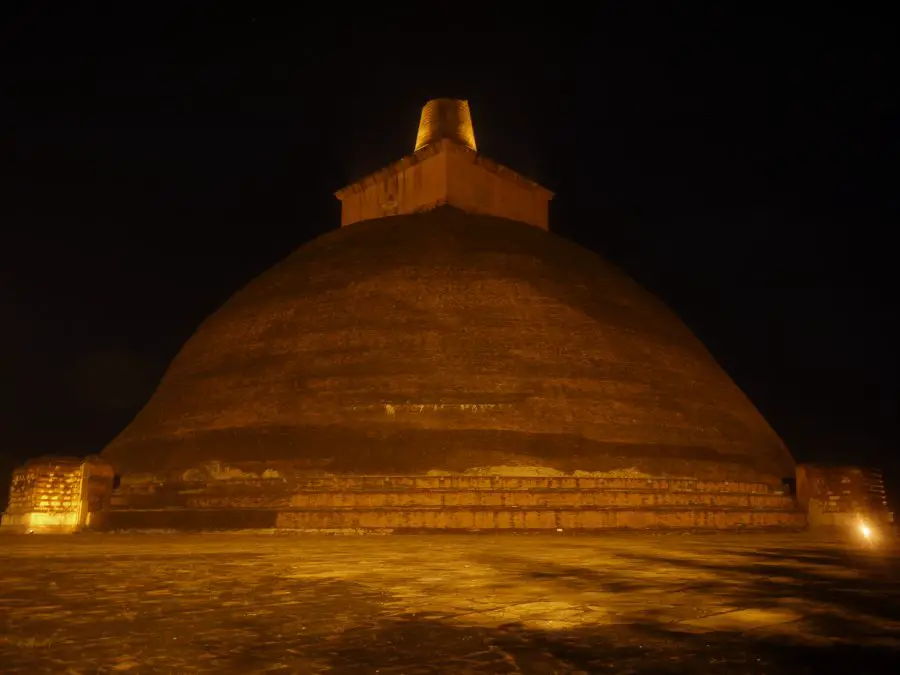
The imposing, redbrick Jetavanarama Dagoba is huge! All the red bricks used in the construction would build a three metre high wall, all the way from London to Edinburgh!!
After a long day of cycling and sightseeing we headed back for our guest-house near Nuwara Lake but Anuradhapura had one more surprise for us. Unguarded, by ticket inspectors, the imposing, redbrick Jetavanarama Dagoba came calling us and finding an unmarked path, across a small stream, over a bit of a broken wall, we were standing in the presence of this seventy metre high dagoba. When it was originally built in the third century it was the third tallest structure in the world, after two Egyptian pyramids. It’s said that if you took all the red bricks which were used in the construction of this dagoba, you could build a three metre high wall, all the way from London to Edinburgh, which gives you some idea of the scale of this massive monument.
Wandering around the enormous structure uninterrupted by touts, travellers or even a chipmunk was a special moment in Anuradhapura; it was us, the monument and our thoughts. With this moment in our mind, we snuck back out the way we had come in, grabbed our bikes from their hiding place in the ditch and pedalled away.

Brian is a travel writer, photographer, blogger, travel addict and adventure-junkie. Being outdoors, getting off the beaten track and outside his comfort zone is what makes him tick. Brian’s the dreamer in the relationship; when he’s not travelling, he’s dreaming about it! Keeping fit, cooking, music and red wine take up the rest of his time.
Sign up for our free travel photography Ebook "Faces of Nepal" and you'll also receive our monthly newsletter.


